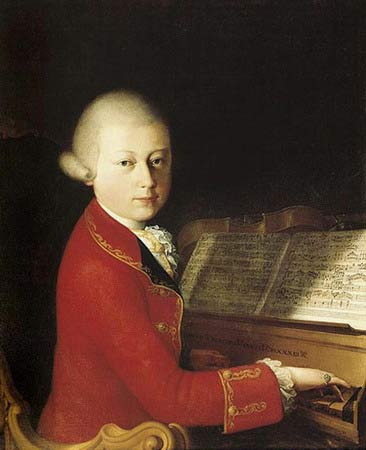 Wolfgang Amadeus Mozart (aged 14) by Saverio dalla Rosa is seen in this handout photograph released in London November 30, 2009. (Agencies)
|
Click for photo of early blood transfusion
|
A gruesome account of a 1666 blood transfusion and amusing notes about how an 8-year-old Mozart responded to tests of his genius were published on Monday as part of an online history of scientific endeavor. The "Trailblazing" website was created by Britain's influential science academy the Royal Society, and includes handwritten papers on some of the most important scientific discoveries of the past three and a half centuries. Benjamin Franklin's studies on flying a kite in an electrical storm from 1752 show the first time anyone had proposed that lightning is electricity and not a supernatural force. And Edward Stone's 1763 notes on the success of willow bark in treating fever document the beginnings of the discovery of salicylic acid and the production of aspirin - now one of the world's most used medicines. The creators of Trailblazing say it is a "go-at-your-own-pace" virtual journey through science which the Royal Society hopes will inspire members of the public to see science as part of everyday life and culture. Martin Rees, president of the Royal Society, said the papers showed "a ceaseless quest by scientists over the centuries...to test and build on our knowledge of humankind and the universe." "They represent those thrilling moments when science allows us to understand better and to see further," he added. The papers, taken from past issues of the oldest scientific journal in the English-speaking world, Philosophical Transactions, also include documents from 1776 on how Captain James Cook saved his sailors from scurvy with pickled cabbage, lemons and malt - long before ideas about nutrition developed. They also include Stephen Hawking's early writing on black holes and Isaac Newton's 1672 landmark work on the nature of light and color and 1940 papers on the discovery of penicillin. Daines Barrington, a skeptical scientist who wanted to test the claim that Mozart was a genius when he visited London in 1770 at the age of eight, notes the musician was as distracted and playful as any normal boy, but showed remarkable talent. "The score was no sooner put upon his desk, than he began to play the symphony in a most masterly manner," he wrote. To see the website, go to trailblazing.royalsociety.org (Read by Guanny Liu. Guanny Liu is a multimedia journalist at the China Daily Web site.) 點(diǎn)擊查看更多雙語新聞
|
本周一,一家網(wǎng)站公布了一些重大科學(xué)發(fā)現(xiàn)的歷史文獻(xiàn)資料,其中包括一篇記述1666年一次可怕的早期輸血經(jīng)歷的文章,以及有關(guān)八歲的莫扎特接受音樂才能測(cè)試的有趣記載。 “開拓”網(wǎng)站由英國(guó)頗具影響力的科研機(jī)構(gòu)皇家學(xué)會(huì)創(chuàng)辦,該網(wǎng)站公布了過去350年間一些重大科學(xué)發(fā)現(xiàn)的研究手稿。 這其中包括1752年本杰明?富蘭克林在雷電中放風(fēng)箏的相關(guān)研究報(bào)告,該研究首次證明閃電是電力,而非某種超自然力。 “開拓”網(wǎng)站還公布了愛德華?斯通1763年有關(guān)白柳樹皮可用來退燒的記錄,這是發(fā)現(xiàn)水楊酸,并研制出當(dāng)今最常用的藥物阿司匹林的開端。 “開拓”網(wǎng)站的創(chuàng)建者表示,這是一次可以“按照你自己的腳步”進(jìn)行的虛擬科學(xué)之旅。英國(guó)皇家學(xué)會(huì)希望通過此舉可激發(fā)公眾(對(duì)于科學(xué)的興趣),將其視為日常生活和文化的一部分。 皇家學(xué)會(huì)主席馬丁?里斯稱,這些手稿展示了“科學(xué)家們數(shù)百年來的不懈探索,通過不斷嘗試建立有關(guān)人類和宇宙的知識(shí)體系。” 他說:“這些文稿記載了那些激動(dòng)人心的時(shí)刻,科學(xué),才是讓我們更好、更深入認(rèn)識(shí)世界的方法。” 這些論文文稿均摘自最古老的英文科學(xué)期刊《哲學(xué)學(xué)報(bào)》的過刊。同時(shí)被公布上網(wǎng)的還包括1776年詹姆斯?庫(kù)克船長(zhǎng)如何用腌制甘藍(lán)菜、檸檬和麥芽治愈船員壞血病的記載,這比營(yíng)養(yǎng)學(xué)理論的建立早很多年。 此外,網(wǎng)站還公布了斯蒂芬?霍金有關(guān)黑洞理論的早期著述、艾薩克?牛頓1672年有關(guān)光學(xué)色彩原理的里程碑意義的論著以及1940年發(fā)現(xiàn)青霉素的論著。 網(wǎng)站還刊發(fā)了驗(yàn)證莫扎特是否是音樂神童的趣事。1770年,科學(xué)家戴恩斯?巴林頓在當(dāng)時(shí)年僅八歲的莫扎特訪問倫敦期間特地對(duì)他進(jìn)行了測(cè)試,證實(shí)了莫扎特的音樂才能。根據(jù)他的記載,當(dāng)時(shí)的莫扎特和一般的男孩一樣,愛玩容易分心,但擁有驚人的音樂天賦。 他寫道:“樂譜一擺上架,他就開始極其嫻熟地演奏起交響曲了。” 更多內(nèi)容可登陸trailblazing.royalsociety.org網(wǎng)站上查看。 相關(guān)閱讀 莫扎特死因新說 細(xì)菌感染或?yàn)椤罢鎯础?/font> (中國(guó)日?qǐng)?bào)網(wǎng)英語點(diǎn)津 Julie 編輯蔡姍姍) |
|
Vocabulary: gruesome:causing great horror; horribly repugnant; grisly(可怕的) blood transfusion:輸血 trailblazing: being a pioneer in (a particular subject, technique, etc.)(領(lǐng)導(dǎo)性的,帶頭的) scurvy:壞血病 score:a written or printed piece of music with all the vocal and instrumental parts arranged on staves, one under the other(樂譜) |
